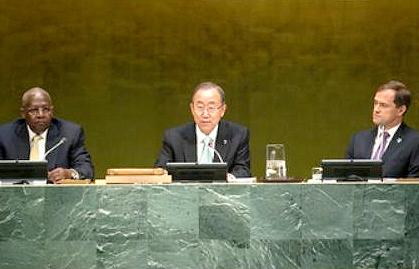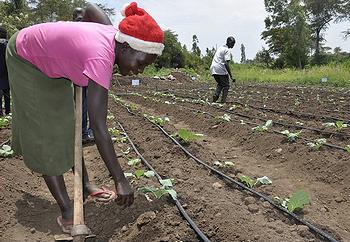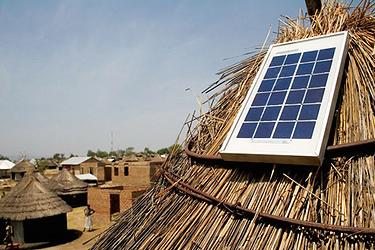
NEW YORK, New York, September 23, 2014 (ENS) – New actions to immediately tackle climate change were announced today by government, business, finance and civil society leaders at the UN Secretary-General’s Climate Summit in New York.
The new initiatives for finance, farming, forests, as well as new coalitions bringing together cities, businesses and citizens will cut emissions and strengthen resilience to the impacts of climate change and global warming.

“Change is in the air. Today’s Climate Summit has shown an entirely new, cooperative global approach to climate change,” Ban said. “The actions announced today by governments, businesses, finance and civil society show that many partners are eager to confront the challenges of climate change together.”
The initiatives announced at United Nations headquarters in New York range from actions that will have a profound impact on global financial markets to more local actions that will reduce the emissions of smallholder farmers.
In the energy sector, two initiatives announced today will be scaled up to expand access to clean, renewable energy for people in eastern and southern Africa and the Small Island Developing States.
“Today shows that the world is finally waking up to the economic and social opportunities of taking action on climate change,” Ban said. “The Climate Summit is showcasing a level of ambition not seen before and producing actions and new initiatives that will make a significant difference.”
Key announcements made today:
Finance: An initiative to mobilize more than US$200 billion in financial resources from public and private sources by the end of 2015. This includes new pledges for the Green Climate Fund, the decarbonization of investment portfolios, moving assets out of fossil fuel-based investments, the continued efforts of national banks to invest in new climate activities, and wide support for putting a price on carbon emissions.
The Summit announcements for climate financing include the following commitments:
* – A coalition of institutional investors has committed to decarbonizing $100 billion in institutional equity investments by the UN climate negotatitions in December 2015, and to measure and disclose the carbon footprint of at least $500 billion in investments.
* – Commercial banks will provide $30 billion in new climate finance by the end of 2015 by issuing green bonds and other innovative financing instruments.
* – The national, bilateral and regional development banks of the International Development Finance Club announced they are on track to increase their direct green/climate financing to $100 billion-a-year for new climate finance activities by the end of 2015.
* – The insurance industry has committed to double its green investments to $84 billion by the end of 2015 and announced that it would increase the amount placed in climate-smart investments to ten times the current amount by 2020. Developed and developing countries have started pulling together to capitalize the Green Climate Fund, by pledging several billion dollars.
* – A group of developed countries announced a commitment of $2 billion to be channeled to the developing countries during 2014-2015 with strong focus on adaptation.
* – Three major pension funds from North America and Europe announced their ambition to accelerate their investments in low-carbon investments across asset classes up to more than $31 billion by 2020.
* – More than 70 countries and 1,000 companies endorsed the need for developing mechanisms that would adequately reflect the true costs relating to polluting and emissions; and over 30 leading companies endorsed the Caring for Climate Business Leadership Criteria on Carbon Pricing, which include setting an internal carbon price high enough to materially affect investment decisions to drive down greenhouse gas emissions.
Forests: More than 150 partners, including 28 government, eight subnational governments, 35 companies, 16 indigenous peoples groups, and 45 NGO and civil society groups, are signing the New York Declaration on Forests which calls for cutting the loss of forests in half by 2020 and ending it a decade later in 2030. The declaration is backed by commitments, including pledges of resources and actions from the private sector, governments and civil society.

The Declaration reaffirms and stretches commitments to reforestation and halting deforestation.
Supporting this are a basket of strong commitments by the private sector, including palm oil companies and food companies, Indigenous Peoples and governments – from local through national – to financial support for REDD+, deforestation programs at scale, and deforestation-free supply chains for commodities on which we all rely.
Over 20 global food companies committed to deforestation-free sourcing policies of palm oil. Three of these – the world’s largest palm oil companies, Wilmar, Golden Agri-Resources and Cargill – committed additionally to work together in Indonesia on implementation with governments and Indigenous Peoples.
Taken together, the share of palm oil under zero deforestation commitments has grown from zero to about 60 percent in the last year, with potential to reduce 400-450 million tons of CO2 per year by 2020, or two billion tons in the period through 2020.
Cities: Mayors from around the world, including New York, Seoul, Paris, Johannesburg, Bogota, and Copenhagen, announced the signing of the Mayor’s Compact that will harmonize their members’ targets and strategies.
* – Among the over 2,000 in the Compact, 228 cities have voluntary targets and strategies for greenhouse gas reductions, that could avoid up to 2.1 gigatonnes of greenhouse gas emissions per year.
* – City networks also announced a harmonized transparent approach and platform to reducing city emissions which will help coordinate efforts and make them more transparent.

Agriculture: Initiatives to promote Climate-Smart Agriculture were announced with the goal of helping 500 million smallholder farmers reduce their emissions and build resilience to the impacts of climate change:
* – A newly launched Global Alliance for Climate-Smart Agriculture was supported by more than 40 governments, organizations and companies.
Countries joining represent millions of farmers, at least a quarter of the world cereal production, 43 million undernourished people and 16 percent of total agricultural greenhouse gas emissions.
* – An Africa Climate-Smart Agriculture Alliance will help some 25 million farming households across Africa practice climate-smart agriculture by 2025.
* – Fortune 500 companies, including Kellogg Company, McDonalds and Walmart, committed to increase the amount of food in their respective supply chains produced with climate-smart approaches.
Industry: Five significant initiatives to address emissions reductions were made by business partners, with special emphasis to reduce potent short-lived climate pollutants – including methane, black carbon (soot), and hydrofluorocarbons (HFCs) – that can have immediate impact and slow the increase in global temperatures expected over the next 35 years by as much as 0.6°C while benefiting people’s health and the production of food.
* – The Oil & Gas Methane Partnership was launched, bringing companies, including ENI of Italy, Pemex; the U.S. gas company Southwestern Energy; Norway’s Statoil Group; BG Group, the former British Gas, and Thailand’s oil and gas company, PTT, together with the Natural Resources Defense Council and Environmental Defense Fund and governments from major oil and gas producing countries, including Mexico, Nigeria, Norway, the Russian Federation and the United States, to reduce methane emissions, one of the most potent greenhouse gases. This unique platform to reduce methane emissions in the industry provides a robust transparent and collaborative approach for businesses, governments and CSOs to work together.
* – The Oil and Gas Climate Initiative also announced by Saudi Aramco on behalf of others engaged, including BG Group, Eni, PEMEX and TOTAL aims to build a platform to share best practices within the industry, address key climate risks, and catalyze meaningful action and coordination on climate change in areas such as energy access, renewable energy, energy efficiency, reduction of gas flaring and methane emissions, among others – followed by regular reporting on ongoing efforts.
* – More than 25 cities committed to develop and carry out quantifiable plans of action to reduce short-lived climate pollutants from the waste sector by 2020. The network is anticipated to expand to 50 cities by next year with the goal of 150 cities by 2020, and eventually to include 1,000 cities.
* – Global corporate leaders such as Deutsche Post, DHL and IKEA, and green freight programs, such as Green Freight Europe and Eco Stars, launched a coordinating mechanism – the Global Green Freight Action Plan – to support more than 20 countries and about two dozen leading NGOs, multinational and intergovernmental organizations that aim to align and enhance existing efforts toward cleaner freight delivery.
* – More than 20 countries and 10 international organizations announced their support to begin formal negotiations of an amendment to phase down the production and consumption of HFCs under the Montreal Protocol, while emissions accounting and reporting would remain under the United Nations Framework Convention on Climate Change – stressing the need to begin formal negotiations in November 2014.
Renewable Energy: Two new initiatives aimed at providing clean, renewable energy to developing countries in Eastern and Southern Africa and in Small Island Developing States.

* – Ministers from 19 eastern and southern African countries endorsed the Africa Clean Energy Corridor initiative, which will advance the development of renewable energy projects and has potential to cut annual carbon dioxide emission levels by 2030 by 310 metric tonnes throughout the Eastern and Southern Africa Power Pools. Cooperation on renewable energy deployment in the region would reduce generation costs by 4 percent and nearly triple electricity supply, transforming the current energy mix of a large portion of the African continent.
* – The Small Island Developing States Lighthouse initiative, a framework for action to support the island countries as they transform their energy systems to include a greater share of renewable energy, was launched. Through partnerships and focused cooperation, the initiative aims to mobilize $500 million within five years and deploy 100 megawatts of new solar photovoltaic capacity, consisting of new wind power, significant quantities of small hydropower and geothermal energy, and marine technology.
Energy Efficiency: Leaders from more than 40 countries, 30 cities and dozens of corporations launched large-scale commitments on energy efficiency to cut emissions of greenhouse gases and reduce energy costs.
* – Vehicle Fuel Efficiency. Ten countries – Bangladesh, Chile, Costa Rica, Ethiopia, Indonesia, Nepal, Serbia, Sri Lanka, Uruguay and Vietnam – are making firmer commitments to adopt and implement policies under the Global Fuel Economy Initiative. Thirty more countries are working with GFEI at various stages of developing fuel economy policies. The goal of GFEI is to double the efficiency of all new vehicles by 2030 and all vehicles by 2050. This would save more than 1 gigatonnes of CO2 a year by 2025 and more than 2 gigatonnes annually by 2050.

* – Lighting Efficiency. More than 10 countries in Asia and the Pacific are joining the 55 countries already committed to phasing out inefficient incandescent lamps by 2016, as part of the UNEP/GEF en.lighten partnership to improve efficiency of residential lighting. They will collectively save more than 2 terawatt hours in electricity consumption yearly, reducing by 440 kilotonnes their emissions of CO2 and lowering their electricity bills by more than $270 million each year.
* – Twenty-eight countries have expressed their willingness to join a new Global Partnership on Appliances and Equipment, which seeks to improve energy performance standards for large appliances. The use of high-efficiency air conditioners, refrigerators and fans alone in these countries will reduce electricity consumption by 165 TWh per year, avoiding emission of 54 million tonnes of GHGs annually, and saving more than $22 billion in electricity bills each year.
* – Building Efficiency is a new initiative being launched to help city, state, regional and national governments speed up adoption of policies that promote energy-efficient buildings. National and municipal governments launching the partnership include Copenhagen (Denmark), Lima (Peru), Mexico City (Mexico), Milwaukee (USA) and Toyama (Japan). Among the business partners supporting the process are Johnson Controls, Velux, Philips and United Technologies.
* – District Energy Systems aims to support cities or regional and national governments develop, retrofit or scale up district energy systems. These systems consolidate the provision of heating and cooling to a group of buildings, often using waste heat from an industrial facility.
Cities joining this initiative include: Anshan (Liaoning Province, China), Betim (Brazil), Bogotá (Colombia), Focsani (Romania), Helsinki (Finland), Jinan (Shandong Province, China), London (UK), Milano (Italy), Nairobi (Kenya), Paris (France), Quito (Ecuador), Recife (Brazil), San Jose (Costa Rica), Santiago de Cali (Colombia), Seoul (Republic of Korea), Sorocaba (Brazil), St. Paul (USA), Vancouver (Canada) and Vaxjo (Sweden). Action by these 19 cities could avoid more than five megatonnes of CO2 emissions annually.
Private sector partners include: Danfoss, Grundfos, Siemens, Vattenfall, Veolia, Climespace and Empower.
Resilience: A variety of innovative resilience initiatives were announced at the Summit, including many that will strengthen countries and communities on the climate front lines. These include:
* – An initiative to provide user-friendly “news you can use” climate information for countries around the world.
* – The African Risk Capacity, an innovative financial tool for mitigating risks from extreme weather events, announced an expansion of its services and coverage, including the introduction of Catastrophe Bonds. The initiative aims to transfer the burden of climate risk away from governments – and the farmers and pastoralists whom they protect – to the ARC, an African-owned, African Union-led financial entity that can better handle these risks.
* – An initiative to integrate climate risk into the financial system was launched in response to the expanding number of extreme weather events. Investors, credit ratings agencies, insurers and financial regulators unveiled the initiative to develop climate risk stress testing for banking and securities regulation, as well as public and private sector accounting practices.
Transport: Four global transport alliances will significantly scale up proven low-carbon transport technologies, including initiatives to increase the number of electric vehicles on the road, increase the efficiency of rail transport and air travel, and provide sustainable public transportation options around the world.
* – A new Urban Electric Mobility Initiative will increase the number of electric vehicles in cities to least 30 percent of all new vehicles sold annually by 2030.

* – The International Association of Public Transport Declaration on Climate Leadership resulted in over 350 commitments and actions from 110 public transport entities in 39 countries to reduce greenhouse gas emissions through a host of measures, from increasing the number of new bus and metro lines to introducing car and bike sharing in countries around the globe – from Germany to Japan and from Colombia to Lebanon.
* – The International Union of Railways (UIC) – with 240 members worldwide, including the major railways of Europe, China, Russia, India and the United States – launched the Low-Carbon Sustainable Rail Transport Challenge. It aims to increase rail use for freight and transport and meet ambitious targets for increased efficiency and emission reduction of 50 percent each by 2030 and 60 and 75 percent, respectively, by 2050. This initiative could result in 75 percent reduction of carbon dioxide emissions from rail transport by 2050.
* – The International Civil Aviation Organization (ICAO) and the aviation industry, represented through the cross-industry Air Transport Action Group (ATAG), stepped up commitments to achieve the industry’s long-term existing global goal to halve net CO2 emissions by 2050 compared to 2005 levels, including to implement a global market-based measure for international aviation for implementation from 2020 onward. Over 100 actions by partners and industry leaders – including Virgin Atlantic and Thai Airways – have been launched or scaled up since the Secretary-General’s call to action for the Summit in Sept 2013.
New coalitions across these areas and more stepped forward with bold announcements, including more than 160 institutions and local governments and more than 500 individuals committed to divesting $50 billion from fossil fuel investments within the next 3-5 years and to reinvest in new energy sources.
A full list of the announcements and commitments made at the Climate Summit can be found at www.un.org/climatechange/summit
Individual country and regional commitments include:
Brazil: Country will submit a national climate adaptation plan in the next year.
Brunei: 63 percent reduction in energy consumption by 2035
Chile: By 2025, 45 percent of Chile’s energy will be green
Costa Rica: 100 percent clean energy by 2016
Cyprus: Committed to EU 2030 legal framework for a 40 percent greenhouse gas reduction
Denmark: Reduce emissions by 40 percent in 2020. The country aims to be fossil free by 2050.
Estonia: County committing 3 million Euros to projects in low-lying states
Ethiopia: President says the country will have zero net emissions by 2025
European Union: Cut emissions by 80 to 95 percent by 2050. It will also provide 14 billion Euros of public climate finance to partners outside the EU over the next seven years
Finland: Phasing out coal in power stations by 2025. It will also contribute to the Green Climate Fund
France: Will commit $1 billion to Green Climate Fund over the next few years
Georgia: Prime Minister says ambition is to “be a hydro-power giant.” The country is working to be carbon neutral by 2050
Iceland: Country says it’s committed to becoming an entirely fossil fuel-free economy
Indonesia: Cut emissions by 26 percent by 2020, says it can raise that number to 40 percent with international help
Ireland: Reduce greenhouse gases by 80 percent by 2050.
Korea, South: Next year, Korea says it will become the first Asian country with a national trading scheme. It also pledged $100 million to Green Climate Fund
Mexico: By 2018, more than one-third of electricity-generating capacity will be based on renewables
Monaco: Reduce carbon emissions by 80 percent by 2050
Nicaragua: 90 percent of energy needs will be met through renewable resources by 2020.
Norway: Will contribute $500 million per year through 2020 to combat climate change
Palau: Supports World Bank initiative to place price tag on carbon
Peru: Regulations to control deforestation
Switzerland: Considering at least a $100 million contribution to the Green Climate Fund
Trinidad and Tobago: 100 percent of the country’s electricity will come from natural gas, supporting net-zero global emissions goal before end of the century
Turkey: Will expand forests by 1.3 million hectares in coming years
United Kingdom: Cut emissions by 80 percent by 2050 and will commit 4 billion Pounds of climate finance
News of announcements made at the Summit can be followed on Twitter from @climate2014live at the hashtag #climate2014.
Copyright Environment News Service (ENS) 2014. All rights reserved.
